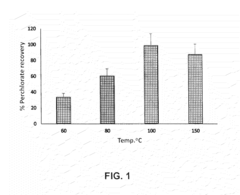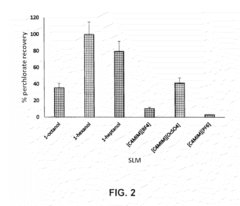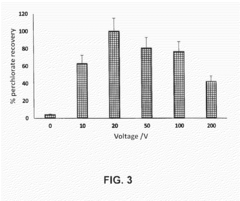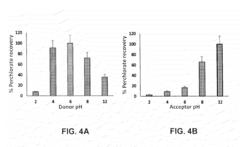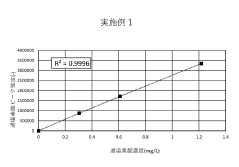Analytical Techniques for Measuring Perchloric Acid in Complex Mixtures
AUG 4, 20259 MIN READ
Generate Your Research Report Instantly with AI Agent
Patsnap Eureka helps you evaluate technical feasibility & market potential.
Perchloric Acid Analysis Background and Objectives
Perchloric acid (HClO4) analysis has become increasingly important in various fields, including industrial processes, environmental monitoring, and scientific research. The development of analytical techniques for measuring perchloric acid in complex mixtures has evolved significantly over the past few decades, driven by the need for more accurate, sensitive, and reliable detection methods.
The primary objective of this technical research is to explore and evaluate the current state-of-the-art analytical techniques for measuring perchloric acid in complex mixtures. This investigation aims to provide a comprehensive understanding of the available methodologies, their strengths, limitations, and potential areas for improvement.
Historically, the analysis of perchloric acid has been challenging due to its strong oxidizing properties and potential interference from other chemical species in complex matrices. Early detection methods relied on traditional titration techniques, which often lacked the sensitivity and specificity required for accurate quantification in complex mixtures.
As technology advanced, more sophisticated analytical techniques emerged, including spectrophotometric methods, electrochemical sensors, and chromatographic approaches. These developments have significantly improved the ability to detect and quantify perchloric acid in various sample types, ranging from environmental samples to industrial process streams.
The evolution of analytical instrumentation has played a crucial role in enhancing the capabilities of perchloric acid analysis. High-performance liquid chromatography (HPLC) coupled with mass spectrometry (MS) has become a powerful tool for separating and identifying perchloric acid in complex mixtures. Additionally, the introduction of ion chromatography (IC) has provided a robust platform for the analysis of perchlorate ions, which are closely related to perchloric acid.
Recent advancements in sensor technology have led to the development of novel electrochemical and optical sensors specifically designed for perchloric acid detection. These sensors offer the potential for real-time monitoring and on-site analysis, addressing the growing demand for rapid and portable analytical solutions.
The ongoing research in this field is focused on overcoming the remaining challenges, such as improving detection limits, enhancing selectivity in the presence of interfering species, and developing more efficient sample preparation techniques. Furthermore, there is a growing interest in exploring the applications of artificial intelligence and machine learning algorithms to enhance data analysis and interpretation in perchloric acid measurements.
As we delve deeper into this technical research, we will examine the current analytical landscape, evaluate the performance of different techniques, and identify promising avenues for future development. The ultimate goal is to provide insights that will guide the selection and optimization of analytical methods for measuring perchloric acid in complex mixtures across various applications and industries.
The primary objective of this technical research is to explore and evaluate the current state-of-the-art analytical techniques for measuring perchloric acid in complex mixtures. This investigation aims to provide a comprehensive understanding of the available methodologies, their strengths, limitations, and potential areas for improvement.
Historically, the analysis of perchloric acid has been challenging due to its strong oxidizing properties and potential interference from other chemical species in complex matrices. Early detection methods relied on traditional titration techniques, which often lacked the sensitivity and specificity required for accurate quantification in complex mixtures.
As technology advanced, more sophisticated analytical techniques emerged, including spectrophotometric methods, electrochemical sensors, and chromatographic approaches. These developments have significantly improved the ability to detect and quantify perchloric acid in various sample types, ranging from environmental samples to industrial process streams.
The evolution of analytical instrumentation has played a crucial role in enhancing the capabilities of perchloric acid analysis. High-performance liquid chromatography (HPLC) coupled with mass spectrometry (MS) has become a powerful tool for separating and identifying perchloric acid in complex mixtures. Additionally, the introduction of ion chromatography (IC) has provided a robust platform for the analysis of perchlorate ions, which are closely related to perchloric acid.
Recent advancements in sensor technology have led to the development of novel electrochemical and optical sensors specifically designed for perchloric acid detection. These sensors offer the potential for real-time monitoring and on-site analysis, addressing the growing demand for rapid and portable analytical solutions.
The ongoing research in this field is focused on overcoming the remaining challenges, such as improving detection limits, enhancing selectivity in the presence of interfering species, and developing more efficient sample preparation techniques. Furthermore, there is a growing interest in exploring the applications of artificial intelligence and machine learning algorithms to enhance data analysis and interpretation in perchloric acid measurements.
As we delve deeper into this technical research, we will examine the current analytical landscape, evaluate the performance of different techniques, and identify promising avenues for future development. The ultimate goal is to provide insights that will guide the selection and optimization of analytical methods for measuring perchloric acid in complex mixtures across various applications and industries.
Industrial Demand for Perchloric Acid Detection
The demand for accurate and reliable methods to detect perchloric acid in complex mixtures has been steadily increasing across various industrial sectors. This growing need is primarily driven by the widespread use of perchloric acid in numerous applications, including analytical chemistry, electropolishing, rocket propellants, and pharmaceutical manufacturing.
In the chemical industry, perchloric acid plays a crucial role as a powerful oxidizing agent and catalyst. The ability to precisely measure its concentration in reaction mixtures and final products is essential for quality control and process optimization. Similarly, the electronics sector relies on perchloric acid for etching and cleaning semiconductor materials, necessitating stringent monitoring of acid levels to ensure product quality and worker safety.
The aerospace and defense industries have a particularly high demand for perchloric acid detection techniques. As a key component in solid rocket propellants, accurate measurement of perchloric acid is critical for ensuring the performance and safety of rocket systems. This has led to increased investment in research and development of advanced analytical methods capable of detecting trace amounts of perchloric acid in complex propellant formulations.
Environmental monitoring and remediation efforts also contribute significantly to the industrial demand for perchloric acid detection. The potential environmental impact of perchlorate contamination has prompted regulatory agencies to establish strict guidelines for perchlorate levels in soil and water. This has created a substantial market for sensitive and selective analytical techniques capable of measuring perchloric acid and its salts in environmental samples.
The pharmaceutical industry represents another major driver of demand for perchloric acid detection methods. Perchloric acid is used in the synthesis of various pharmaceutical compounds, and its accurate quantification is crucial for ensuring product purity and compliance with regulatory standards. The need for high-throughput screening methods in drug discovery and development has further intensified the search for rapid and reliable perchloric acid detection techniques.
As industrial processes become increasingly complex and automated, there is a growing demand for real-time, in-situ monitoring of perchloric acid concentrations. This trend is particularly evident in the chemical manufacturing sector, where continuous process monitoring is essential for maintaining optimal production conditions and ensuring product consistency. The development of robust, field-deployable analytical techniques for perchloric acid detection is therefore a key focus area for many instrument manufacturers and analytical service providers.
In the chemical industry, perchloric acid plays a crucial role as a powerful oxidizing agent and catalyst. The ability to precisely measure its concentration in reaction mixtures and final products is essential for quality control and process optimization. Similarly, the electronics sector relies on perchloric acid for etching and cleaning semiconductor materials, necessitating stringent monitoring of acid levels to ensure product quality and worker safety.
The aerospace and defense industries have a particularly high demand for perchloric acid detection techniques. As a key component in solid rocket propellants, accurate measurement of perchloric acid is critical for ensuring the performance and safety of rocket systems. This has led to increased investment in research and development of advanced analytical methods capable of detecting trace amounts of perchloric acid in complex propellant formulations.
Environmental monitoring and remediation efforts also contribute significantly to the industrial demand for perchloric acid detection. The potential environmental impact of perchlorate contamination has prompted regulatory agencies to establish strict guidelines for perchlorate levels in soil and water. This has created a substantial market for sensitive and selective analytical techniques capable of measuring perchloric acid and its salts in environmental samples.
The pharmaceutical industry represents another major driver of demand for perchloric acid detection methods. Perchloric acid is used in the synthesis of various pharmaceutical compounds, and its accurate quantification is crucial for ensuring product purity and compliance with regulatory standards. The need for high-throughput screening methods in drug discovery and development has further intensified the search for rapid and reliable perchloric acid detection techniques.
As industrial processes become increasingly complex and automated, there is a growing demand for real-time, in-situ monitoring of perchloric acid concentrations. This trend is particularly evident in the chemical manufacturing sector, where continuous process monitoring is essential for maintaining optimal production conditions and ensuring product consistency. The development of robust, field-deployable analytical techniques for perchloric acid detection is therefore a key focus area for many instrument manufacturers and analytical service providers.
Current Challenges in Complex Mixture Analysis
The analysis of complex mixtures presents numerous challenges in the field of analytical chemistry, particularly when attempting to measure specific compounds such as perchloric acid. One of the primary difficulties lies in the intricate nature of these mixtures, which often contain a wide array of components with varying chemical properties and concentrations. This complexity can lead to significant interference and matrix effects, making it challenging to accurately isolate and quantify the target analyte.
Spectral overlap is a common issue in complex mixture analysis, where the signals of different compounds may interfere with each other, obscuring the specific signature of perchloric acid. This problem is exacerbated when dealing with trace amounts of the target analyte, as the signal-to-noise ratio becomes increasingly unfavorable. Additionally, the presence of other strong oxidizing agents or acids in the mixture can further complicate the analysis, as they may exhibit similar chemical behaviors or react with perchloric acid, altering its detectable form.
Sample preparation and extraction techniques pose another set of challenges. The diverse nature of complex mixtures often requires sophisticated separation methods to isolate perchloric acid effectively. However, these processes can be time-consuming, labor-intensive, and may introduce additional sources of error or contamination. Moreover, the stability of perchloric acid during sample handling and analysis is a critical concern, as it can decompose or react with other components under certain conditions, leading to inaccurate measurements.
The development of selective and sensitive analytical methods for perchloric acid in complex matrices is an ongoing challenge. Traditional techniques such as titration or colorimetric methods may lack the necessary specificity or sensitivity for accurate quantification in complex environments. More advanced instrumental techniques like ion chromatography or mass spectrometry offer improved performance but come with their own set of limitations, including high costs, complex operation, and potential matrix effects.
Calibration and standardization present additional hurdles in complex mixture analysis. The diverse and often unpredictable composition of these samples makes it difficult to create representative calibration standards that accurately mimic the matrix effects encountered in real-world samples. This can lead to systematic errors in quantification and challenges in method validation across different sample types.
Furthermore, the potential for chemical reactions or equilibrium shifts within the complex mixture during analysis adds another layer of complexity. These dynamic processes can alter the concentration or chemical form of perchloric acid, making it challenging to obtain reliable and reproducible results. Researchers must carefully consider and control factors such as pH, temperature, and sample storage conditions to minimize these effects.
Spectral overlap is a common issue in complex mixture analysis, where the signals of different compounds may interfere with each other, obscuring the specific signature of perchloric acid. This problem is exacerbated when dealing with trace amounts of the target analyte, as the signal-to-noise ratio becomes increasingly unfavorable. Additionally, the presence of other strong oxidizing agents or acids in the mixture can further complicate the analysis, as they may exhibit similar chemical behaviors or react with perchloric acid, altering its detectable form.
Sample preparation and extraction techniques pose another set of challenges. The diverse nature of complex mixtures often requires sophisticated separation methods to isolate perchloric acid effectively. However, these processes can be time-consuming, labor-intensive, and may introduce additional sources of error or contamination. Moreover, the stability of perchloric acid during sample handling and analysis is a critical concern, as it can decompose or react with other components under certain conditions, leading to inaccurate measurements.
The development of selective and sensitive analytical methods for perchloric acid in complex matrices is an ongoing challenge. Traditional techniques such as titration or colorimetric methods may lack the necessary specificity or sensitivity for accurate quantification in complex environments. More advanced instrumental techniques like ion chromatography or mass spectrometry offer improved performance but come with their own set of limitations, including high costs, complex operation, and potential matrix effects.
Calibration and standardization present additional hurdles in complex mixture analysis. The diverse and often unpredictable composition of these samples makes it difficult to create representative calibration standards that accurately mimic the matrix effects encountered in real-world samples. This can lead to systematic errors in quantification and challenges in method validation across different sample types.
Furthermore, the potential for chemical reactions or equilibrium shifts within the complex mixture during analysis adds another layer of complexity. These dynamic processes can alter the concentration or chemical form of perchloric acid, making it challenging to obtain reliable and reproducible results. Researchers must carefully consider and control factors such as pH, temperature, and sample storage conditions to minimize these effects.
Existing Analytical Methods for Perchloric Acid
01 Improved measurement techniques for perchloric acid
Advanced techniques have been developed to enhance the accuracy of perchloric acid measurements. These methods include novel sensor designs, improved calibration procedures, and the use of specialized analytical instruments. These advancements contribute to more precise and reliable quantification of perchloric acid in various applications.- Improved measurement techniques for perchloric acid: Advanced techniques have been developed to enhance the accuracy of perchloric acid measurements. These methods may include spectroscopic analysis, electrochemical sensors, or chromatographic separation, which can provide more precise and reliable results compared to traditional methods.
- Specialized equipment for perchloric acid analysis: Dedicated instruments and devices have been designed specifically for measuring perchloric acid concentrations with high accuracy. These may include custom-built analyzers, automated sampling systems, or specialized sensors that are optimized for perchloric acid detection.
- Calibration and standardization methods: Improved calibration techniques and standardization procedures have been developed to ensure the accuracy of perchloric acid measurements. These may involve the use of certified reference materials, inter-laboratory comparisons, or advanced statistical methods for data analysis and validation.
- Environmental and safety considerations in measurement: Techniques have been developed to improve the accuracy of perchloric acid measurements while addressing environmental and safety concerns. These may include methods for minimizing sample handling, reducing exposure risks, or implementing safer measurement protocols in laboratory settings.
- Data processing and error reduction algorithms: Advanced data processing techniques and error reduction algorithms have been implemented to improve the accuracy of perchloric acid measurements. These may include machine learning approaches, signal processing methods, or statistical models that can compensate for various sources of measurement error.
02 Automated systems for perchloric acid analysis
Automated systems have been designed to streamline the process of measuring perchloric acid concentrations. These systems incorporate advanced robotics, computer-controlled sampling, and real-time data analysis to minimize human error and increase measurement accuracy. Such automation enhances reproducibility and efficiency in perchloric acid quantification.Expand Specific Solutions03 Specialized equipment for perchloric acid handling
Specialized equipment has been developed for the safe handling and precise measurement of perchloric acid. This includes corrosion-resistant materials, advanced containment systems, and purpose-built measurement devices. These innovations contribute to improved safety and accuracy in perchloric acid-related processes.Expand Specific Solutions04 Calibration methods for perchloric acid measurement
Advanced calibration methods have been established to ensure the accuracy of perchloric acid measurements. These techniques involve the use of certified reference materials, multi-point calibration curves, and statistical analysis to minimize systematic errors. Proper calibration is crucial for maintaining high measurement accuracy across different concentration ranges.Expand Specific Solutions05 Integration of spectroscopic techniques
Spectroscopic techniques have been integrated into perchloric acid measurement systems to enhance accuracy. These methods, such as Raman spectroscopy or infrared spectroscopy, provide additional data points for concentration determination. The combination of spectroscopic data with traditional measurement techniques results in more robust and accurate perchloric acid quantification.Expand Specific Solutions
Key Players in Analytical Instrumentation
The analytical techniques for measuring perchloric acid in complex mixtures are in a mature stage of development, with a well-established market and diverse applications across industries. The global market for these techniques is substantial, driven by the increasing demand for precise chemical analysis in sectors such as pharmaceuticals, environmental monitoring, and industrial processes. Key players in this field include Ecolab USA, Inc., Shimadzu Corp., and F. Hoffmann-La Roche Ltd., who have developed advanced analytical instruments and methodologies. The technology's maturity is evident in the involvement of research institutions like the Naval Research Laboratory and the Centre National de la Recherche Scientifique, which continue to refine and expand the capabilities of these analytical techniques.
Naval Research Laboratory
Technical Solution: The Naval Research Laboratory (NRL) has developed advanced analytical techniques for measuring perchloric acid in complex mixtures. Their approach combines ion chromatography with conductivity detection and mass spectrometry for high sensitivity and selectivity[1]. NRL's method utilizes a specialized anion exchange column to separate perchlorate from interfering ions, followed by suppressed conductivity detection. For enhanced specificity, they employ electrospray ionization mass spectrometry in negative ion mode, monitoring the perchlorate anion at m/z 99 and 101[2]. This dual detection system allows for quantification down to sub-ppb levels in various matrices including water, soil, and biological samples[3].
Strengths: High sensitivity and selectivity, capable of detecting trace levels of perchlorate in complex environmental and biological matrices. Weaknesses: Requires sophisticated instrumentation and expertise to operate, potentially limiting widespread adoption.
Shimadzu Corp.
Technical Solution: Shimadzu Corporation has developed a comprehensive analytical solution for measuring perchloric acid in complex mixtures using their advanced liquid chromatography-mass spectrometry (LC-MS) systems. Their approach utilizes ultra-high performance liquid chromatography (UHPLC) coupled with triple quadrupole mass spectrometry for precise quantification[4]. Shimadzu's method employs a specialized HILIC (Hydrophilic Interaction Liquid Chromatography) column for efficient separation of perchlorate from other anions in the sample. The mass spectrometer operates in multiple reaction monitoring (MRM) mode, targeting specific perchlorate ion transitions for enhanced selectivity[5]. This technique allows for rapid analysis times (typically under 10 minutes) and detection limits in the low ng/L range, even in complex environmental and industrial samples[6].
Strengths: Rapid analysis time, high sensitivity, and excellent selectivity in complex matrices. Weaknesses: High initial equipment cost and need for skilled operators may limit accessibility for some laboratories.
Innovative Approaches in Perchlorate Detection
Method of detecting and quantifying perchlorate contamination
PatentInactiveUS20160146753A1
Innovation
- A microwave-assisted parallel electromembrane extraction method coupled with ion chromatography, where samples are digested with acid and heated in a microwave system, followed by electromembrane extraction across a membrane impregnated with a solvent, and then analyzed using ion chromatography, allowing for simultaneous extraction and cleanup of multiple samples.
Method for quantifying perchloric acid
PatentInactiveJP2022146894A
Innovation
- A method involving a transfer step with an alkaline aqueous solution to separate perchloric acid from tertiary amine in the organic phase to the aqueous phase, followed by reversed-phase high-performance liquid chromatography using an ion pair agent for quantification.
Safety Protocols for Perchloric Acid Handling
Handling perchloric acid requires strict adherence to safety protocols due to its highly reactive and potentially explosive nature. Proper safety measures are essential to protect personnel, equipment, and facilities from the hazards associated with this powerful oxidizing agent.
Personal protective equipment (PPE) is crucial when working with perchloric acid. Laboratory personnel must wear chemical-resistant gloves, a lab coat, and safety goggles or a face shield. In cases where splashing or aerosol formation is possible, additional protective gear such as a chemical-resistant apron and closed-toe shoes should be worn.
Ventilation is a critical aspect of perchloric acid safety. All operations involving perchloric acid must be conducted in a properly designed fume hood with a wash-down system. This specialized fume hood helps prevent the accumulation of explosive perchlorates on surfaces and ductwork. Regular cleaning and maintenance of these fume hoods are essential to prevent the buildup of potentially hazardous residues.
Storage of perchloric acid requires specific considerations. It should be stored in a cool, dry area away from organic materials, reducing agents, and other incompatible substances. Glass or other inert containers should be used, and secondary containment is recommended to prevent spills from spreading. Inventory management is crucial to ensure that old or discolored perchloric acid, which may have formed unstable compounds, is properly disposed of.
Emergency response procedures must be in place and well-communicated to all personnel working with perchloric acid. This includes the location and proper use of safety showers, eyewash stations, and spill control materials. A specific spill response kit for perchloric acid should be readily available, containing appropriate neutralizing agents and absorbents.
Training is a fundamental component of perchloric acid safety protocols. All personnel who handle or work near perchloric acid must receive comprehensive training on its hazards, proper handling techniques, and emergency procedures. This training should be regularly updated and documented.
Waste disposal of perchloric acid and its solutions requires special attention. It should never be allowed to dry out, as this can lead to the formation of explosive perchlorates. Proper neutralization and dilution procedures must be followed, and disposal should be carried out in accordance with local regulations and institutional guidelines.
Regular safety audits and inspections of areas where perchloric acid is used or stored are essential to maintain a safe working environment. These audits should verify compliance with safety protocols, the integrity of storage containers, and the proper functioning of safety equipment.
Personal protective equipment (PPE) is crucial when working with perchloric acid. Laboratory personnel must wear chemical-resistant gloves, a lab coat, and safety goggles or a face shield. In cases where splashing or aerosol formation is possible, additional protective gear such as a chemical-resistant apron and closed-toe shoes should be worn.
Ventilation is a critical aspect of perchloric acid safety. All operations involving perchloric acid must be conducted in a properly designed fume hood with a wash-down system. This specialized fume hood helps prevent the accumulation of explosive perchlorates on surfaces and ductwork. Regular cleaning and maintenance of these fume hoods are essential to prevent the buildup of potentially hazardous residues.
Storage of perchloric acid requires specific considerations. It should be stored in a cool, dry area away from organic materials, reducing agents, and other incompatible substances. Glass or other inert containers should be used, and secondary containment is recommended to prevent spills from spreading. Inventory management is crucial to ensure that old or discolored perchloric acid, which may have formed unstable compounds, is properly disposed of.
Emergency response procedures must be in place and well-communicated to all personnel working with perchloric acid. This includes the location and proper use of safety showers, eyewash stations, and spill control materials. A specific spill response kit for perchloric acid should be readily available, containing appropriate neutralizing agents and absorbents.
Training is a fundamental component of perchloric acid safety protocols. All personnel who handle or work near perchloric acid must receive comprehensive training on its hazards, proper handling techniques, and emergency procedures. This training should be regularly updated and documented.
Waste disposal of perchloric acid and its solutions requires special attention. It should never be allowed to dry out, as this can lead to the formation of explosive perchlorates. Proper neutralization and dilution procedures must be followed, and disposal should be carried out in accordance with local regulations and institutional guidelines.
Regular safety audits and inspections of areas where perchloric acid is used or stored are essential to maintain a safe working environment. These audits should verify compliance with safety protocols, the integrity of storage containers, and the proper functioning of safety equipment.
Environmental Impact of Perchlorate Analysis
The environmental impact of perchlorate analysis is a critical consideration in the development and application of analytical techniques for measuring perchloric acid in complex mixtures. Perchlorate contamination has become a significant environmental concern due to its widespread presence in soil and water resources, primarily resulting from industrial and military activities.
The analysis of perchlorate in environmental samples plays a crucial role in assessing the extent of contamination and guiding remediation efforts. However, the analytical process itself can have environmental implications that must be carefully managed. Traditional methods for perchlorate analysis often involve the use of hazardous chemicals and generate significant amounts of waste, contributing to potential environmental risks.
Recent advancements in analytical techniques have focused on developing more environmentally friendly approaches. Ion chromatography coupled with mass spectrometry (IC-MS) has emerged as a preferred method due to its high sensitivity and selectivity. This technique minimizes the use of harmful reagents and reduces waste generation compared to older methods. Additionally, the development of solid-phase extraction (SPE) techniques for sample preparation has further reduced the environmental footprint of perchlorate analysis by decreasing solvent consumption and improving analyte recovery.
The environmental impact of perchlorate analysis extends beyond the laboratory setting. Field-portable analytical devices are being developed to enable on-site testing, reducing the need for sample transportation and associated carbon emissions. These portable systems often employ miniaturized versions of established techniques, such as capillary electrophoresis or microfluidic devices, which require smaller sample volumes and generate less waste.
Efforts to mitigate the environmental impact of perchlorate analysis have also focused on the development of green analytical chemistry principles. This approach emphasizes the use of renewable resources, the elimination or reduction of hazardous substances, and the design of energy-efficient analytical processes. For instance, researchers are exploring the use of ionic liquids as environmentally benign alternatives to traditional organic solvents in sample preparation and analysis.
The disposal of perchlorate-containing waste from analytical procedures remains a significant environmental concern. Proper management and treatment of these wastes are essential to prevent further environmental contamination. Advanced oxidation processes and biological treatment methods are being investigated as potential solutions for the degradation of perchlorate in laboratory waste streams.
As analytical techniques for measuring perchloric acid in complex mixtures continue to evolve, it is crucial to consider their life cycle environmental impact. This includes assessing the energy consumption, resource utilization, and waste generation associated with the entire analytical process. By adopting a holistic approach to environmental impact assessment, researchers and analytical chemists can work towards developing more sustainable and eco-friendly methods for perchlorate analysis, ultimately contributing to improved environmental protection and management strategies.
The analysis of perchlorate in environmental samples plays a crucial role in assessing the extent of contamination and guiding remediation efforts. However, the analytical process itself can have environmental implications that must be carefully managed. Traditional methods for perchlorate analysis often involve the use of hazardous chemicals and generate significant amounts of waste, contributing to potential environmental risks.
Recent advancements in analytical techniques have focused on developing more environmentally friendly approaches. Ion chromatography coupled with mass spectrometry (IC-MS) has emerged as a preferred method due to its high sensitivity and selectivity. This technique minimizes the use of harmful reagents and reduces waste generation compared to older methods. Additionally, the development of solid-phase extraction (SPE) techniques for sample preparation has further reduced the environmental footprint of perchlorate analysis by decreasing solvent consumption and improving analyte recovery.
The environmental impact of perchlorate analysis extends beyond the laboratory setting. Field-portable analytical devices are being developed to enable on-site testing, reducing the need for sample transportation and associated carbon emissions. These portable systems often employ miniaturized versions of established techniques, such as capillary electrophoresis or microfluidic devices, which require smaller sample volumes and generate less waste.
Efforts to mitigate the environmental impact of perchlorate analysis have also focused on the development of green analytical chemistry principles. This approach emphasizes the use of renewable resources, the elimination or reduction of hazardous substances, and the design of energy-efficient analytical processes. For instance, researchers are exploring the use of ionic liquids as environmentally benign alternatives to traditional organic solvents in sample preparation and analysis.
The disposal of perchlorate-containing waste from analytical procedures remains a significant environmental concern. Proper management and treatment of these wastes are essential to prevent further environmental contamination. Advanced oxidation processes and biological treatment methods are being investigated as potential solutions for the degradation of perchlorate in laboratory waste streams.
As analytical techniques for measuring perchloric acid in complex mixtures continue to evolve, it is crucial to consider their life cycle environmental impact. This includes assessing the energy consumption, resource utilization, and waste generation associated with the entire analytical process. By adopting a holistic approach to environmental impact assessment, researchers and analytical chemists can work towards developing more sustainable and eco-friendly methods for perchlorate analysis, ultimately contributing to improved environmental protection and management strategies.
Unlock deeper insights with Patsnap Eureka Quick Research — get a full tech report to explore trends and direct your research. Try now!
Generate Your Research Report Instantly with AI Agent
Supercharge your innovation with Patsnap Eureka AI Agent Platform!
